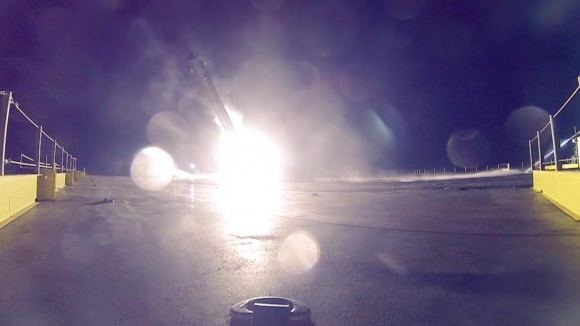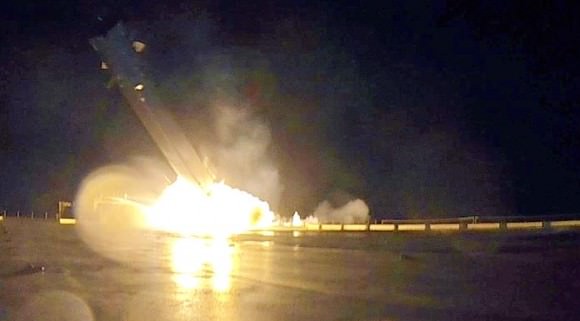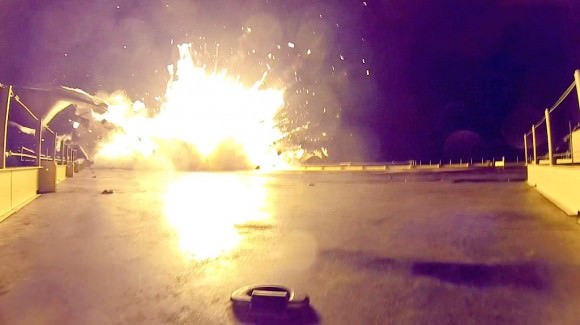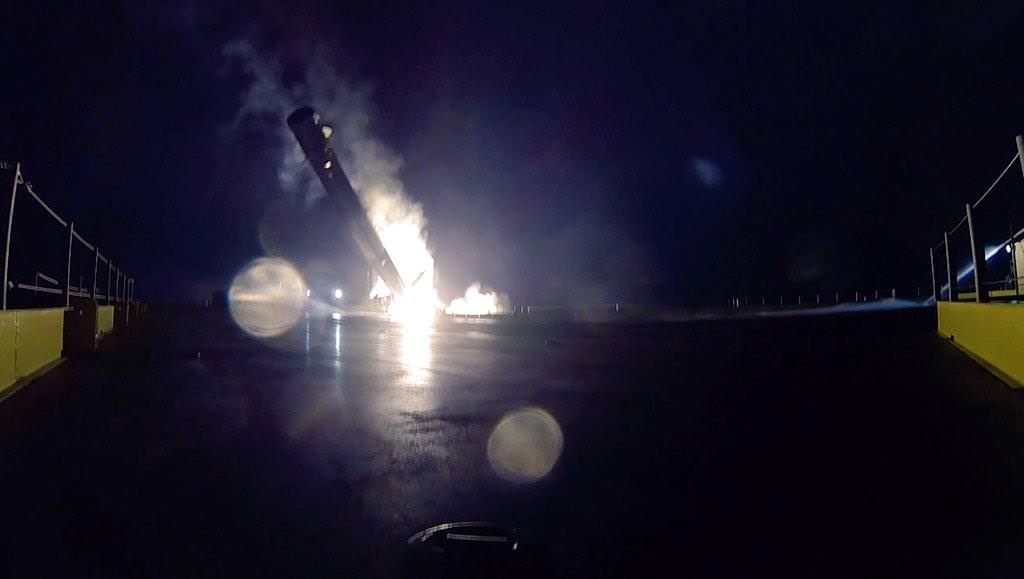Rocket hits hard at ~45 deg angle, smashing legs and engine section. Credit: SpaceX/Elon Musk
See video below[/caption]
Dramatic new photos and video of the daring and mostly successful attempt by Space X to land their Falcon 9 booster on an ocean-going “drone ship” were released this morning, Friday, Jan. 16, by SpaceX CEO and founder Elon Musk.
Musk posted the imagery online via his twitter account and they vividly show just how close his team came to achieving total success in history’s first attempt to land and recover a rocket on a tiny platform in the ocean.
Here’s the video: “Close, but no cigar. This time.”
The rocket landing and recovery attempt was a secondary objective of SpaceX, that immediately followed the spectacular nighttime blastoff of the Falcon 9 on Jan. 10 carrying the SpaceX Dragon cargo freighter spacecraft on a critical resupply mission for NASA bound for the space station.
The history making attempt at recovering the Falcon 9 first stage was a first of its kind experiment to accomplish a pinpoint soft landing of a rocket onto a miniscule platform at sea using a rocket assisted descent by the first stage Merlin engines aided by steering fins.
The first stage rocket reached an altitude of over 100 miles after firing nine Merlins as planned for nearly three minutes. It had to be slowed from traveling at a velocity of about 2,900 mph (1300 m/s). The descent maneuver has been likened to someone balancing a rubber broomstick on their hand in the middle of a fierce wind storm.
The imagery shows the last moments of the descent as the rocket hits the edge of the drone ship at a 45 degree angle with its four landing legs extended and Merlin 1D engines firing.

Musk tweeted that the first stage Falcon 9 booster ran out of hydraulic fluid and thus hit the barge.
“Rocket hits hard at ~45 deg angle, smashing legs and engine section,” Musk explained today.
Lacking hydraulic fluid the boosters attached steering fins lost power just before impact.
“Before impact, fins lose power and go hardover. Engines fights to restore, but …,” Musk added.

This ultimately caused the Falcon 9 to crash land as the legs and engine section were smashed and destroyed as the fuel and booster burst into flames. The ship survived no problem.
“Residual fuel and oxygen combine.”
“Full RUD (rapid unscheduled disassembly) event. Ship is fine minor repairs. Exciting day!” said Musk.
“Rocket made it to drone spaceport ship, but landed hard. Close, but no cigar this time. Bodes well for the future tho,” Musk tweeted within hours after the launch and recovery attempt.
As I wrote on launch day here at Universe Today, despite making a ‘hard landing’ on the vessel dubbed the ‘autonomous spaceport drone ship,’ the 14 story tall Falcon 9 first stage did make it to the drone ship, positioned some 200 miles offshore of the Florida-Carolina coast, northeast of the launch site in the Atlantic Ocean. The rocket broke into pieces upon hitting the barge.
Whereas virtually every other news outlet quickly declared the landing attempt a “Failure” in the headline, my assessment as a scientist and journalist was the complete opposite!!
In my opinion the experiment was “a very good first step towards the bold company goal of recovery and re-usability in the future” as I wrote in my post launch report here at Universe Today.
Listen to my live radio interview with BBC 5LIVE conducted Saturday night (Jan. 11 UK time), discussing SpaceX’s first attempt to land and return their Falcon-9 booster.
“Is it safe? Was SpaceX brave or foolhardy? Why is this significant? Will SpaceX succeed in the future?” the BBC host asked me.
I replied; “It was a 99% success” and more …..
“Am super proud of my crew for making huge strides towards reusability on this mission. You guys rock!” Musk declared in a later tweet.
SpaceX achieved virtually all of their objectives in the daunting feat except for a soft landing on the drone ship.
This was a bold experiment involving re-lighting one of the first stage Merlin 1D engines three times to act as a retro rocket to slow the stages descent and aim for the drone ship.
Four attached hypersonic grid fins and a trio of Merlin propulsive burns succeeded in slowing the booster from hypersonic velocity to subsonic and guiding it to the ship.
The drone ship measures only 300 feet by 170 feet. That’s tiny compared to the Atlantic Ocean.
The first stage was planned to make the soft landing by extending four landing legs to a width of about 70 feet to achieve an upright landing on the platform with a accuracy of 30 feet (10 meters).
No one has ever tried such a landing attempt before in the ocean says SpaceX. The company has conducted numerous successful soft landing tests on land. And several soft touchdowns on the ocean’s surface. But never before on a barge in the ocean.
So they will learn and move forward to the next experimental landing, that could come as early as a few weeks on the launch of the DSCOVR mission in late January or early February.
“Upcoming flight already has 50% more hydraulic fluid, so should have plenty of margin for landing attempt next month.”

Musk’s daring vision is to recover, refurbish and reuse the first stage and dramatically reduce the high cost of access to space, by introducing airline like operational concepts.
It remains to be seen whether his vision of reusing rockets can be made economical. Most of the space shuttle systems were reused, except for the huge external fuel tanks, but it was not a cheap proposition.
But we must try to cut rocket launch costs if we hope to achieve routine and affordable access to the high frontier and expand humanity’s reach to the stars.
The Falcon 9 launch itself was a flawless success, blasting off at 4:47 a.m. EST on Jan. 10 from Space Launch Complex 40 at Cape Canaveral Air Force Station in Florida.
The Dragon CRS-5 spacecraft was loaded with over 5108 pounds (2317 kg) of scientific experiments, technology demonstrations, the CATS science payload, student research investigations, crew supplies, spare parts, food, water, clothing and assorted research gear for the six person crew serving aboard the ISS.
It successfully rendezvoused at the station on Jan. 12 after a two day orbital chase, delivering the critical cargo required to keep the station stocked and humming with science.
Stay tuned here for Ken’s continuing Earth and planetary science and human spaceflight news.



“- Is it safe”?
The best answer would’ve been:
“-Is your radio show safe?”
The space age is happening now. Almost no one knows about it, because no president made a pompous speech about it. And our phantastic mass media will not inform anyone about it.
66.75 degrees to be precise as Spock or Mr Data might have chimed in. The Fx component of the thrust vector was about 39% of the total thrust and the rocket in the final seconds did not have a lot of lateral motion. Likewise, there was not much vertical motion remaining. If one has an estimate of the thrust and the drag coefficient for a cylinder (bluff body), a rough estimate of the crosswinds in play could be derived. If there was gimbaling going on, the Fx could be higher or lower but still, there must have been some significant crosswind. Checkout 747 pilots on youtube tackling crosswinds. Crabbing is one of the fun and legal things one can do with an aircraft. In the final seconds of the Falcon core landing, its pretty apparent that the grid fins could not have helped much to resolve the attitude problem with or without sufficient hydraulic fluid. Anyways – this is great! And Kudos to the SpaceX Team!!! Try again!
As its hydro fluid, you should probably compare it to taking a turn with your car and the steering gets stuck in the turning position.
Painful if the final piece of the road is straight (down).
In the meantime, recent launches by Boeing and Orbital Sciences also failed, because they didn’t even try. They also passed up the opportunity to learn by not trying.
By releasing these images, SpaceX is proving to me that they are open and not ruled by PR people that would have never allowed these photos to get out in the public.
I like this company.
10
If I were Elon Musk I’d limit my launches to daylight hours. Where we can see the rockets coming down from many angles and get continuous coverage. I’d drag the whole human race behind me. Give the whole world a cause to live for. Something to dream about.
Unless you’re doing the launch entirely for developmental purposes like this, what you suggest may not be consistent with the orbital mechanics requirements of your customer’s payload.
And that’s your first priority. The money from that is what enables the cool experimental stuff…
No matter what the media think, this was a great achievement. This was a live mission which did what it had to, deliver cargo to the ISS. The attempted landing was an extra. Test pilots fly new planes to make sure they fly as expected and sometimes they don’t. This was like that, a test flight/landing. From what has been learnt this time, will make it better next time. It may still fail, but in the end it will work. A reusable first stage is a big step, but the Space Shuttle had reusable solid fuel boosters and the Shuttle engines were multi-use too. The problem with that was the long and expensive refurbishment of the Shuttle itself. Elon Musk has done what he has with his own company SapceX and not massive government funding. I think that speaks for itself.
Spectacular video and be good in an Imax!
Surprised there hasn’t been more video released.
I wonder why the descent speed was not slowed by a parachute before switching on to rocket guidance.
But good attempt and reminds me of the early moon lander video games.
As I understand grid fins, their efficacy is in the hypersonic regime. I think they would not have had enough control authority at the final few seconds of the landing even if the hydraulics had enough fluid. It seems that the gas thrusters were trying to compensate, as were the gimbaled engines, most likely at their stops, so I suspect the lack of hydraulics was responsible for the landing being too far off the target trajectory that would have had the stage nearly upright in those final few seconds and allowed small thruster and gimbal movements to complete the landing.
What I don’t understand is the phrase, “running out of hydraulic fluid”. Hydraulic systems are closed systems. If it ran out of fluid, that sounds like a leak to me. If they are adding 50% more fluid, is it to prevent loss of control if it leaks again or does it normally lose fluid during operation? If it’s the former, then it seems to me the cause of the leak needs to be prevented to begin with. If it’s the latter, well, I never heard of that before.
You’re not the only one that was wondering about that.
Yep I wondered that too.
Musk’s reply to a similar question on Twitter: Hydraulics are usually closed, but that adds mass vs short acting open systems. F9 fins only work for 4 mins. We were ~10% off.
So now we have a new acronym: RUD Rapid Unscheduled Disassembly.
For a non-governmental program, Musk appears to have mastered government-speak.
What a riot. Doesn’t “explosion” pretty much cover it? 😉
I liked this acronym, shows a certain sense of humour oft found lacking in the bureaucratic environment. Also use of the E word might garner interest from other humourless government agencies that track such keywords. 🙂